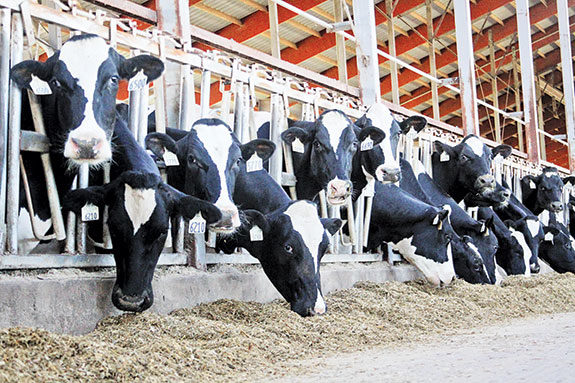Many of the protein sources used in dairy rations are byproducts of the production of oil for food and industrial uses: soybean meal, sesame seed meal, linseed meal and canola meal, for example. While most oilseeds have been available since ancient times, canola was developed relatively recently.
Using standard breeding techniques, plant geneticists at the University of Manitoba and the University of Saskatchewan set out to improve several shortfalls associated with the oilseed rapeseed and developed canola.
Rapeseed, used as a source of industrial oil, grew well under western Canadian conditions but fell short as a food or feed source. The oil contained an undesirable fatty acid called erucic acid, and the meal contained toxic components known as glucosinolates.
However, from the mid-1950s to the 1970s, plant breeders were able to eliminate these less-than-desirable components from canola. Canola oil is now recognized worldwide for its health attributes and canola meal for its superb biology when fed to beef and dairy cattle. Canola has been used with success for the last 30 years.
Statistics Canada has referred to canola as “a crop that never stops improving.” In the mid-1970s, canola was still a fledgling industry, with little information available. Currently, Canada produces more than 10 million tons of canola seed each year, with demand growing rapidly and expected to reach 15 million tons by 2015.
Since canola was first produced, geneticists have developed varieties that are more resistant to disease, weeds and drought, tolerant of salinity and earlier maturing. Yields have also increased at a steady pace. The latest statistics show that canola contributes more than $15 billion to the Canadian economy annually, making it Canada’s most valuable crop.

After oil is extracted from the canola seed, the meal remains, which represents approximately 60 percent of the weight of the canola seed.
Proximate analyses show that canola meal matches up very closely to other oilseeds in composition. ( See Table 1 .)
As Table 1 shows, canola meal’s composition is very similar to the other commonly used oilseed meals.
With the exception of soybean meal, all of the proteins are fibrous and the energy contents are similar. Protein levels are below 40 percent for distillers grains, linseed meal and canola meal.
From these values, it is very difficult to select the protein source that provides the best return to dairy farmers. Thus, the Canola Council of Canada (CCC) is supporting research to determine the value of canola meal protein in much greater detail, so producers and nutritionists will be better able to determine the actual value of canola in their specific feeding situation.
The CCC is the national association representing the value chain of the canola industry. The association’s membership is composed of growers, suppliers, seed handlers, exporters, food and feed manufacturers and governments, with funding provided by industry stakeholders.
Initiatives undertaken by this organization bring value to the industry by identifying opportunities in the marketplace.
Research currently under way at the Dairy Forage Research Center in Wisconsin is evaluating the variability of canola meal based upon the source. The type of equipment used to extract the oil and the techniques used can have an impact on the value of the protein to dairy cows.
These details can be used to optimize meal production parameters. These researchers are also looking at how proteins degrade in the rumen and are re-evaluating the use of soluble protein in ration formulation.
Agriculture and Agri-Food Canada is involved in two studies looking into canola meal and its use in dairy rations.
The first of these studies is reviewing all research conducted on canola meal since 1975 to determine how canola meal has influenced milk production since it was presented as a dairy protein source. Findings have stated that when canola replaced other vegetable proteins, milk production and milk protein increased.
The second study being conducted by Agriculture and Agri-Food Canada has shown that canola meal does not degrade in the rumen as quickly as soybean meal or distillers grains. The group is working to link these two studies, which will result in improved tabular values for canola meal, as well as soybean meal and distillers grains.
A series of large field studies comparing canola meal and distillers grains are also under way in California. Distillers grains are often available at a low cost but rarely support high levels of milk production.
Research has found that when fed together, canola meal protein complements the protein in distillers grain very well. Further research will work to divulge the optimum ratio of distillers grain and canola meal to provide the highest level of milk production, milk protein and profitability.
This same premise is being investigated at South Dakota State University . Under a research setting, this study will provide details of the mechanisms involved in feeding canola with distillers grains.
It is true that canola has never stopped improving throughout its existence. Canola growers and suppliers continue to provide the information for dairy nutritionists to make fact-based decisions.
Canola meal may or may not be the optimum protein source for your dairy ration, but the research currently being conducted will allow you to make your decisions with confidence. PD
PHOTOS
TOP RIGHT: Research is being done to determine the value of canola meal protein in much greater detail, so producers and nutritionists will be better able to determine the actual value of canola in their specific feeding situation. Photo courtesy of Canola Council of Canada.

Essi Evans
Technical Advisory Services












